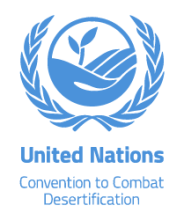Resource information
Many Small Island Developing States (SIDS) have committed to establishing national voluntary LDN targets. By establishing LDN targets, SIDS have defined their ambitions and key priorities to address land degradation. The LDN target setting process allowed national stakeholders to systematically analyze the causes and effects of land degradation and to come up with evidence-based decisions on what is desirable and feasible to avoid, reduce or reverse land degradation by 2030. Based on an assessment of the actions and priorities identified by SIDS in their national LDN target setting country reports, the key priorities to achieve LDN in SIDS are summarized in this briefing note. Leveraging on the building blocks of the LDN TSP with nationally determined contributions (NDCs) of UNFCCC, the Aichi Biodiversity Targets of the CBD, and the Sendai Framework of the United Nations Office for Disaster Risk Reduction (UNDRR), along with monitoring of SDG targets, particularly 15.3, has further consolidated LDN in SIDS. This leveraging enables setting specific measurable targets for the advancement of the SLM agenda of the UNCCD as well as other MEAs including the SDGs, SAMOA Pathway, Paris Agreement and Sendai Framework. Moreover, it is essential to integrate LDN and climate actions within national strategic land-use planning mechanisms to ensure that SDGs are met by 2030 and disaster risks are kept to a minimum. It is important for SIDS to further acquire highly accurate spatial land-cover and elevation data and to develop adequate human resource skills to put in place an LDN GIS and remote sensing system at the national level. These will be used to continuously monitor and periodically assess the progress of LDN in SIDS to ensure its implementation by 2030. The provision of digital/high-resolution imagery and data will help SIDS to predict the extent of future damages and losses occurring due to sea level rise, coastal erosion, saline water intrusion, flash floods and landslides. Building capacity and bridging the knowledge gap in achieving LDN in SIDS will improve the national land-use planning process by encouraging efficient land-resource allocation to various economic and land-use sectors, while ensuring ecosystem functions are restored and protected. The setting up of a regional LDN knowledge e-platform for tracking, monitoring and reporting is essential to the advancement of LDN in SIDS. It will advance peer learning of LDN best practices among SIDS and promote the sharing of data and knowledge at both regional and global levels.


